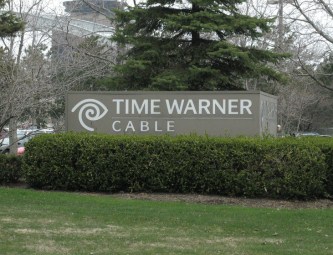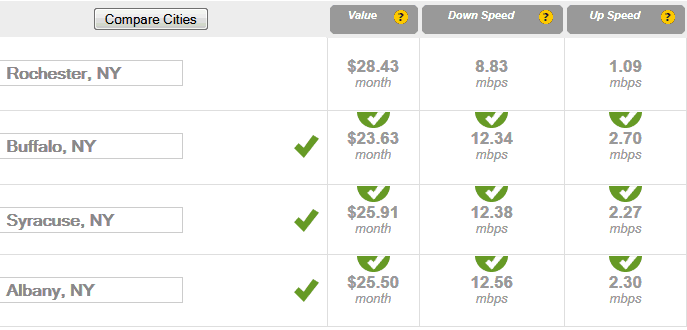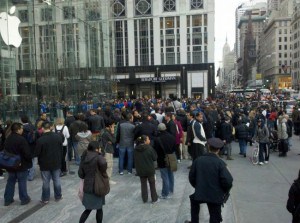
The crowds in New York City waiting for iPad 2 to arrive. (Courtesy: Digital Trends)
You have to give Apple credit. Nobody knows how to design a product for intuitiveness, sex appeal, and downright usability like Apple. Although I have never been devoted to the Macintosh or other Apple personal computers, nobody can deny Apple has had one success after another with their personal communications and entertainment devices:
- iPod – It changed music players the same way the Sony Walkman did a generation earlier;
- iPhone – Not since Ben & Jerry’s Chocolate Chip Cookie Dough ice cream have I seen people literally fight over something.
- iPad – The only tablet I have found tolerable.
Acquiring these products, particularly around launch time, is often an experience. Apple is the ultimate control freak when it comes to managing its product releases, with pages of requirements about how, when, and where people will be able to acquire the latest Apple Anything. They also know how to stage events guaranteed to bring the media out.
And so last Friday, in the middle of a nasty wind-whipped snowy day, there I was standing outside of a Best Buy store in Victor, N.Y., with around 75 others waiting in line to acquire iPad 2 (it’s not “the iPad” I learned — it’s just “iPad” thank you very much.)
It could have been worse. At the Apple Store inside Eastview Mall, adjacent to Best Buy, hundreds were camped out, with some arriving with the early morning mall walkers. A much smaller group gathered at Target and Wal-Mart, two other retailers who were part of the opening day festivities.
An hour before the 5pm official start of sales, I was #15 in line — not bad, but not great either in the 5 degree wind chill. Not since a CompUSA Thanksgiving night promotion a few years ago had I waited in a significant line for anything. As I chatted up several new-found queue-friends, I began to notice a trend. I was the only one there who did not already own iPad. At one point, while checking the time on my Motorola Droid X phone, audible gasps were heard.
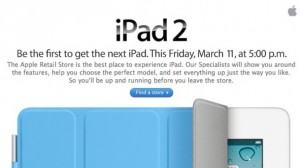 “You… you don’t have an iPhone?” my line neighbor asked, as I realized I was the skunk at Apple’s garden party.
“You… you don’t have an iPhone?” my line neighbor asked, as I realized I was the skunk at Apple’s garden party.
“No, nothing is worth being stuck with AT&T for cell phone service,” I replied, trying to recover from my social faux pas. Not good enough.
The whispering began — “he doesn’t have an iPhone… what is he doing here?”
Eventually, after some friendly interrogation, it was decided I was okay, because at least I owned an iPod Touch, an Apple TV, and a Mac Mini. Besides, there was plenty of time to evangelize me with tales that AT&T wasn’t so bad in Rochester. Hey, the iPhone is available from Verizon, I was told.
Yes, I replied. I sort of knew that.
As members of the crowd texted their compatriots staked out at other retail locations sharing rumors and sightings, we learned the Apple Store crowd was now completely out of hand at the mall just a few hundred yards away.
“The line is down to Macy’s!” one hollered. “I’m glad I came here, instead,” another replied.
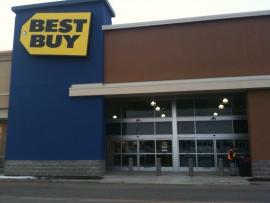
Best Buy's store in Victor, N.Y.
Anxiety levels seemed to increase whenever someone entered or exited the store. Were they line jumping? If an employee emerged, what did they know? Best Buy employees were strictly forbidden, by Apple it turned out, to reveal -anything- about the product people were waiting to buy. How many are on hand? Can’t say. Why are we waiting outside? Because Apple required it. What models will you have? Can’t say that either. What happens if you run out? We will begin taking names for the reservation list tomorrow. Why tomorrow? Apple rules, came the reply.
The frustration of Best Buy management was on full display, knowing full well that any unhappy or disappointed customers were likely to blame Best Buy, not Apple, for being unable to walk away with iPad 2 right then and there.
By 4:45pm, it became clear Target could care less about Apple’s rules, as the first winners in the Apple device lottery emerged from the store waving their conquest. It turned out they had eight units to sell. Wal-Mart had 10. This was not going over well with the Best Buy line, who now wondered how many the Best Buy store in the most wealthy part of greater Rochester would actually have on hand.
At 4:50pm, Best Buy employees emerged with folders described as “tickets” customers could use to buy the units they had to sell. But be careful, we were told. Apple required ticket holders to complete their purchases at Best Buy no later than 6pm or their “ticket” would expire.
Then a fever swept the line as people tried to guess how many tickets Best Buy had to hand out. Not since Charlie and the Chocolate Factory has there been this much excitement over tickets (at least with Willy Wonka you got a chocolate bar as a consolation prize.)

I want iPad 2 NOW! I don't care how much it costs.
Within minutes it became obvious Best Buy had exactly 15 units to sell to a line of 75. Uh oh. Worries over making the “right choice” between the white or black, 16 or 32GB model were replaced with “you will take what we give you and like it.”
And there I was clutching the last folder for a 16GB white model, actually fearing someone might swoop in and grab it. I shook my head — now I am caught up in this silly hysteria.
Instantly, like one of those well-choreographed flash mobs, the losers silently dissolved into the parking lot, heading for their cars, despite Best Buy employees’ best efforts to promise to “take names” tomorrow for future sales. No deal. But one desperate young lady who wandered up minutes later, encouraged seeing only 15 of us preparing to enter the store, flew into a panicked tantrum when she realized they were already sold out.
“I need iPad 2 today! I don’t care what it costs or what model. I need it now,” she wailed.
I realized I’ve just encountered the 2011 reincarnation of Veruca Salt.
“A hardcore Apple junkie,” one of the fellow 15 whispered to a friend.
“Yes, she should have got here hours ago if she was serious,” came the reply. “Amateur.”
With that we were paraded into the store with one manager at the front and another employee at the rear to protect “line integrity.” But it was not the beginning of a magical adventure with a golden ticket. It was still just Best Buy.
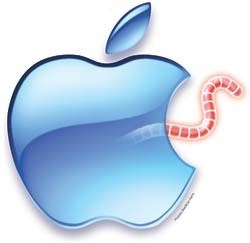
My DOA iPad 2 serves me right. I don't own an iPhone.
Moments later, we were trapped in a “special line” facing upselling snipers trying to pick us off with extended warranty service plans, accessories, and Zagg’s invisibleSHIELD, the product that requires the patience of Job to apply.
“No problem, we can do it for you for $14.95,” an employee chimed in on queue.
Nearly an hour(!) later, I finally managed to get to the register and tell them “no” on the extras, swipe my card, and get the heck outta there.
Later that evening I unwrapped it, plugged it in, and discovered (and later confirmed), it was a dud — dead on arrival. It went back on Saturday.
Lessons Learned:
- It is never worth waiting in line for an hour or more for -anything- unless you enjoy the experience of waiting and chatting people up;
- Being an early adopter means you are a beta tester, bound to end up with early manufacturing boo-boos;
- Steve Jobs is a Bond Villain;
- It’s my own fault. After all, I didn’t have an iPhone.


 Subscribe
Subscribe
